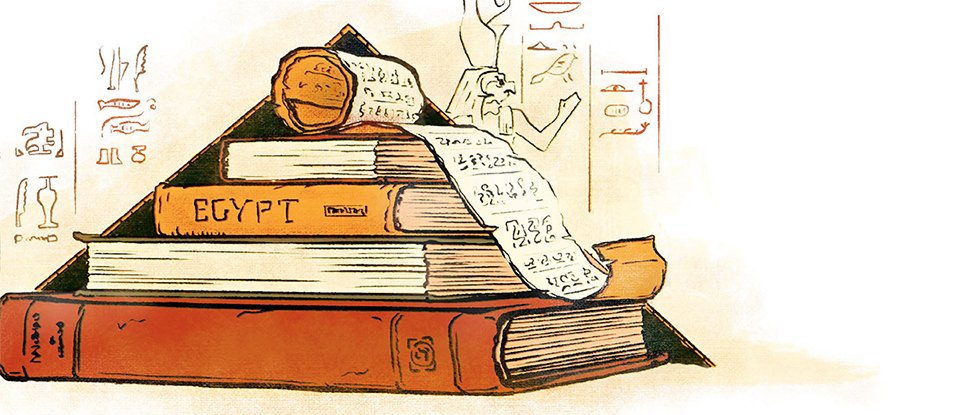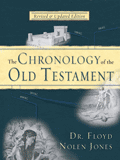
False Egyptian History Undermines God’s Word
Bible Chronology
Archaeologists claim that Egyptian history conflicts with the Bible—but the real problem is with their timeline.
I grew up believing the earth was billions of years old, but I also believed God created everything and never believed in evolution. In those days I had been told the six days in Genesis were really long ages or perhaps a gap existed in Genesis 1—a gap into which the long ages of earth’s history were dumped. No one was sure. Unfortunately, our church did not help in this area, as it often wasted more time arguing about speculative prophetic theories than preparing me for a secular education.
However, after my father died suddenly in 1975, I found some books in his library by Dr. Henry Morris and others. After carefully studying these works, I became a young earth creationist. However, the inaccurate teaching about the days of creation was not the last inaccurate teaching of dates that I’ve encountered.
In 1965, I first learned about Egyptian history in my eleventh-grade ancient history class where we were told their antiquity dated back to about 5000 BC. According to the current teachings, the Egyptians began to build the pyramids around 2700 BC. It never crossed my mind that this conflicted with the dates in the margins of my Bible assigning creation at 4004 BC and the flood at 2349 BC. Those dates were derived from the scholarly study of the biblical text by Archbishop James Ussher in the 1600s. However, we apparently knew better than he did—or so I was told by my teachers.
I later discovered that these inconsistencies stemmed from a disregard for the infallible biblical record.
Though I later discovered that these inconsistencies stemmed from a disregard for the infallible biblical record, the area of archaeology still causes a lot of confusion regarding biblical authority—in particular, how archaeology has been used in attempts to determine the world’s supposed chronology, often conflicting with the true history of the world as recorded in Genesis 1–11.
Rediscovering Ussher’s Work
In 1997, Answers in Genesis founder Ken Ham suggested I republish Ussher’s Annals of the World by rewriting it in modern English. After five years of hard work, my wife, Marion, and I did that, and the work was released in 2003. After the book was published, chronologist Dr. Nolen Jones contacted me concerning an article I had published debunking Edwin Thiele’s book The Mysterious Numbers of the Hebrew Kings.1 (This article became an appendix in my updated translation of Ussher’s book.)
We had both independently arrived at the same conclusions about Thiele’s faulty work, which allegedly harmonized biblical chronology with supposed Assyrian chronology. Although he professed profound respect for the Hebrew writers, Thiele had unfortunately tortured and twisted the Hebrew beyond its plain reading to make it fit his understanding of Assyrian history. True to his book’s title, Thiele’s sophistry made the Hebrew numbers very mysterious.
Newton’s Contribution to Chronology
As a result of our mutual love for ancient history, in 2002, Nolen sent me a reproduction of Sir Isaac Newton’s work The Chronology of the Ancient Kingdoms Amended. As most know, Newton was arguably the greatest scientist who ever lived. What few realize is that he was also a first-rate historian and scholar in many other areas—including chronology.
In its original form, Newton’s book consisted of virtually impenetrable prose. Sentences went on for half a page, and paragraphs continued for six or more pages. The chapters had no subdivisions or subtitles but were printed in old English script with large quotes in Latin and Greek.
The chapter on Greece alone went on for over 200 pages with no breaks or subtitles. It was likely a work in progress since Newton never lived to publish the book. The copy published a year after his death in 1726 by the executor of his estate was difficult for most people to read, much less to understand. Although I looked through it briefly, I did not seriously understand its contents, so I set it aside.
Republishing Newton’s Works
The work Marion and I did on Ussher sold so well that the publisher asked if I could recommend another book on history to sell. I suggested Newton’s work since it covered an earlier time in secular history that Ussher had not dealt with in detail. In 2008, I undertook the effort to republish Newton’s work. Marion typed out the 376-page book just as she had done for Ussher’s book, which was much larger. First, I rewrote it in modern English, then replaced all the Greek and Latin quotations with English translations. I also looked up and verified all of Newton’s historical quotes and reindexed them to reference the Loeb Classical Library, which is the standard set of books that historians use. Additionally, I added an index of every proper name in the book. As a result, the index is larger than the original book and contains a small bibliography for each person mentioned.
Remarkably, Newton kept all of this information in his head, but the rest of us mere mortals require it on paper. While redoing the book, I noticed curiously that many people were mentioned by various historical writers under different names, so much so that I added an “alias index” to help readers sort out who’s who to properly keep track. One example was the Egyptian king Shishak, who had over 40 different names depending on the historian. Imagine the confusion that created for many historians!
Egyptian History Re-Examined
One of the chapters of Newton’s book deals with Egyptian history and Manetho (a third century BC Egyptian priest and historian) and varies greatly from modern scholarship. Most modern historians worship Manetho’s chronological record of the Egyptian kings as if it were the gold standard. Many know it contradicts other portions of acknowledged secular historical interpretations and certainly biblical history, but nonetheless they seem to cling to it like a drowning man to a piece of flotsam.
However, Newton’s meticulous work demonstrates that Manetho’s dynasties are almost a complete work of fiction—and bad fiction at that. As a matter of fact, they were so inaccurate that the priests who created them failed to pass them on to the next generations of Egyptian priests, and in a short time the dynasties were forgotten.
By the time the historian Diodorus Siculus wrote an Egyptian history about 200 years later, these dynasties were completely forgotten. The list of kings the priests gave him compares very closely to what Greek historian Herodotus (c. fifth century BC) was given. Likewise, the Egyptian priests with whom Herodotus talked 200 years earlier than Manetho apparently knew absolutely nothing of these dynasties, for if they had known of them, why did they withhold this information from Herodotus? The priests likely invented these dynasties to give credibility to their exaggerated list of kings.
These fictitious dynasties are used to date the Great Pyramid around 2700 BC instead of around 800 BC, and the same dynasties are the basis for the greatly exaggerated early Egyptian history. From the time of Herodotus to the time of Manetho, the list of kings covered from Herodotus had grown from slightly more than 20 to over 130, and the period had greatly expanded from about 500 years to well over 2,700 years.
All this to say, there are better rotten reeds to lean on when trying to recreate Egyptian history than the mess recorded by Manetho. Newton shows us a better way. First, Newton assumed the biblical history to be correct, then looked for corresponding events recorded by various secular writers, triggered by events in biblical history. Case in point: the Canaanites did not sit idly by waiting to be slaughtered by Joshua, but many fled to other countries. Their flight into Egypt and Libya is noted by various ancient writers.
These were the mysterious shepherd kings (the Canaanites were shepherds) of Egypt who ruled there for about 300 years until the time of King Saul. Their expulsion from Egypt greatly swelled the ranks of the Philistines at that time. When David defeated the Edomites, their mass exodus into Egypt, Greece, and Philistia had a major impact on these countries and was well documented.
The Edomites’ sophisticated knowledge of science and technology radically transformed the countries they fled to. Solomon’s excellent relationships with Egypt and Hiram of Tyre were not accidents. The worldwide conquests of Sesostris (aka Shishak) had a definite impact on Judah and Rehoboam in particular. The defeat of Zerah and his huge army by Asa destabilized Egypt and Ethiopia for many years. And the list goes on and on revealing how Newton constructed his chronology in agreement with scriptural accounts.
Rules of Research
One of the first rules of historical research is that you try to use the primary and oldest sources possible. The rationale is that the more times something is copied, the more likely it will be miscopied. It is like moving a sand pile. Every time you do, you lose a little sand and pick up a little dirt. In the case of Egyptian history, this rule has been blatantly ignored.
The oldest extant work on Egyptian history was completed by Herodotus and is highly esteemed by modern historians as one of the best historiographers from ancient history—indeed, so much so that he is called the Father of History. Egyptian historical records were hard to come by even in the time of Herodotus. Egypt had been invaded many times, by the Ethiopians, Assyrians, Babylonians, and the Persians. Invaders often took a perverse delight in destroying Egyptian records among other things.
For example, the Persian king Cambyses in 524 BC invaded Egypt and destroyed anything and everything he could lay his hands on. When Herodotus visited Egypt about 50 years later, the priests were trying to recreate their history from memory and from the few records missed by Cambyses and not destroyed by other invasions. They started their history with a list of 330 kings who reigned 11,000 years and, except for two, did nothing!
Their list was a tale too tall for even Herodotus to swallow, so he merely mentioned it in passing. The Egyptian priests then related about 20 or so kings who ruled after the expulsion of the shepherd kings down to their time, and they gave detailed accounts of their lives and what they did, which covered a period of about 500 years, in stark contrast to the 330 imaginary kings that preceded them.
Fast forward 200 years to Manetho. The Age Race was on to see who had the oldest kingdom.2 The fertile imagination of the priests had increased the number of kings from about 20 to over 130 and from about 500 years to over 2,700 years. In so doing they created many obvious errors, like four consecutive kings reigning for 50 years each.
Usually if a monarch had reigned a long time, his son would be older when he came to the throne and may have a shorter reign. An example would be Queen Victoria, who had a very long reign, but her son had grown old by the time he was crowned king and reigned for less than 10 years. Newton recognized this, having analyzed a dozen dynasties of kings who actually existed and for whom he had accurate records. He found that the average reign was only about 20 years.
My sister, an accountant, says if she finds a glaring error in an audit at the beginning of the books, she wastes no time looking over the rest, assuming there will be more mistakes. Similarly, the priests had also made chronological errors at the very start of the list of kings who were alive during the priests’ lifetime, demonstrating the untrustworthiness of their work. Historians have violated a fundamental rule by not using the oldest and most reliable sources. Why all modern histories worship this piece of historical fiction is beyond me!
Warning for Christian Authors
Christian authors who write about Egyptian history should carefully consider the work of Newton. Their history must not include more kings than Herodotus recorded for the simple reason that they never existed. If they had, why did the priests not tell Herodotus? They were already trying to exaggerate their antiquity with the list of 330 kings who existed in name only. Why would they knowingly omit a real king and thereby deliberately shorten their history?
Another challenge is that Manetho’s writings were not preserved intact like other writings from ancient history (such as Homer, Herodotus, Polybius, and Strabo). It exists only as referenced by other writers and is quite fragmentary. A rule of thumb is that things of value get preserved. While the Greeks esteemed and preserved many writings (for example, Homer’s Iliad, written about 600 years before Manetho), apparently no one cared enough to preserve the writings of Manetho.
Consequently, Manetho’s fake history was consigned to oblivion and only preserved if mentioned in fragmentary quotations made by other more reliable writers.
Compromise in Modern Study Bibles
Sadly, modern reference Bibles usually date Abraham to around 2100 BC, when in fact he lived about 100 years later, closer to 2000 BC. They provide no continuous chronology from creation (Adam) to Abraham, or forward to the time of David. Even then they disregard the Bible’s authority and base their history on the erroneous chronology fabricated by Edwin Thiele. Ussher solved the problem of biblical chronology 400 years ago, and nothing since has shown that he made a mistake.
The lack of proper dating in the study notes of these Bibles shows that their authors have caved to secular writers for dating. Rather than publish dates that would attract criticism, they usually omit the dates altogether and by so doing relegate the history of Genesis 5 and 11 to the imagination. If you cannot tie an approximate date to an event, it is most likely a fairy tale.
Scientists like the late Dr. Henry Morris, who founded the Institute for Creation Research, realized that the long ages of secular history could not be tweaked to fit the Bible. Instead, they must be pitched and replaced with the biblical timeline of recent creation. So too ancient Egyptian history cannot be tweaked, but needs a total rewrite.
Archaeologists have undermined the Bible starting with the genealogies of Genesis 5 and 11, and worse, most Christian archaeologists raise no objections.
Just as secular scientists have undermined the Bible starting at Genesis 1, so secular archaeologists have undermined the Bible starting with the genealogies of Genesis 5 and 11 and, worse, most Christian archaeologists raise no objections.
Taking Back Genesis Chapter 1
To understand how modern historians have strayed so far off track, we must recognize that modern archaeologists are laboring under a fourfold handicap. First, they are trying to fit their findings into Manetho’s exaggerated time period. Second, they are using an erroneous biblical history (created by Edwin Thiele), which is off by about 50 years. Third, most of them have little or no respect for God’s Word and assume that biblical history is false unless proven true by their research. Fourth, their knowledge of classical history is simplistic at best.
Just as Dr. Henry Morris demolished the myth of long ages, classical history needs a similar person to correct the exaggerated history created by Manetho. Newton has gone a long way in unraveling the conflicting accounts passed down by ancient writers. Newton’s book was only an idle diversion from the scientist’s main scientific work, yet it contains so much valuable information and tremendous original historical insights that it would easily merit several doctoral degrees.
Any book—including any study Bible—that provides a continuous view of Egypt’s history that goes back further than about 1200 BC or lists more than 20 or so kings is inaccurate because it is based in whole or in part on the fake history of Manetho. For the centuries prior to about 1200 BC, the only reliable history we have is the brief sketches of the interactions of the Egyptians with the people of Israel that are provided by the Bible itself. Let’s take back chapters 5 and 11 of Genesis, just as we have taken back chapter 1.3
Footnotes
- Larry Pierce, Evidentialism—The Bible and Assyrian Chronology, Answers in Genesis, April 1, 2001, AnswersInGenesis.org/bible-history/evidentialism-the-bible-and-assyrian-chronology/.
- Larry Pierce, “Chronology Wars,” Answers in Genesis, January 1, 2010, AnswersInGenesis.org/bible-history/chronology-wars/.
- I strongly recommend the updated edition of Newton’s Revised History of Ancient Kingdoms (available to be ordered on the Answers in Genesis website) and the article “Archaeology and the Bible” (at AnswersinGenesis.com). The article shows the shortcomings of archaeology as a source of the truth about anything either secular or biblical.
Recommended Resources

Answers in Genesis is an apologetics ministry, dedicated to helping Christians defend their faith and proclaim the good news of Jesus Christ.
- Customer Service 800.778.3390
- Available Monday–Friday | 9 AM–5 PM ET
- © 2025 Answers in Genesis





